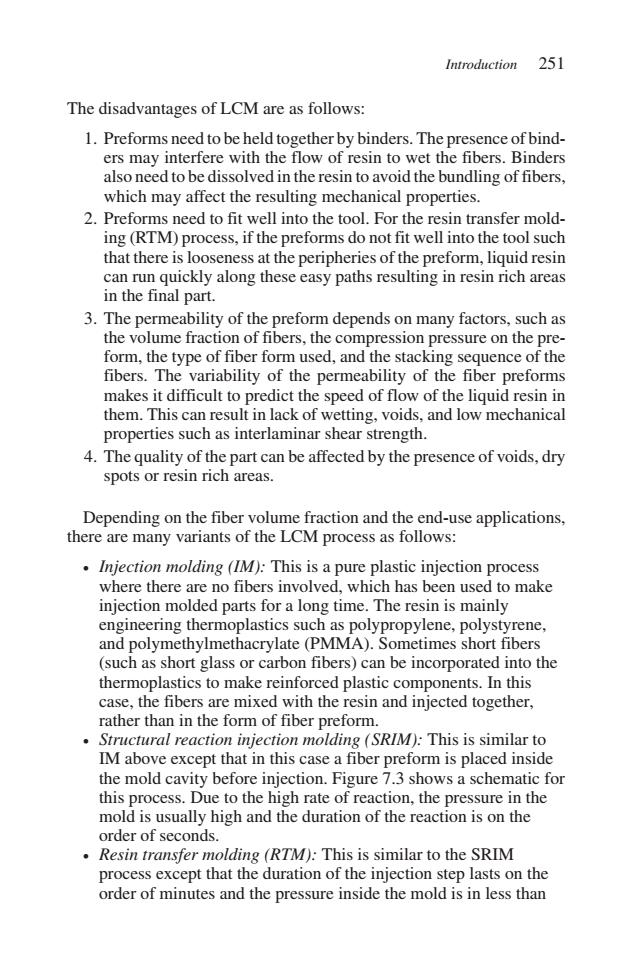正在加载图片...

Introduction 251 The disadvantages of LCM are as follows: 1.Preforms need to be held together by binders.The presence of bind- ers may interfere with the flow of resin to wet the fibers.Binders also need to be dissolved in the resin to avoid the bundling of fibers, which may affect the resulting mechanical properties. 2.Preforms need to fit well into the tool.For the resin transfer mold- ing (RTM)process,if the preforms do not fit well into the tool such that there is looseness at the peripheries of the preform,liquid resin can run quickly along these easy paths resulting in resin rich areas in the final part. 3.The permeability of the preform depends on many factors,such as the volume fraction of fibers,the compression pressure on the pre- form,the type of fiber form used,and the stacking sequence of the fibers.The variability of the permeability of the fiber preforms makes it difficult to predict the speed of flow of the liquid resin in them.This can result in lack of wetting,voids,and low mechanical properties such as interlaminar shear strength. 4.The quality of the part can be affected by the presence of voids,dry spots or resin rich areas. Depending on the fiber volume fraction and the end-use applications, there are many variants of the LCM process as follows: Injection molding (IM):This is a pure plastic injection process where there are no fibers involved,which has been used to make injection molded parts for a long time.The resin is mainly engineering thermoplastics such as polypropylene,polystyrene, and polymethylmethacrylate (PMMA).Sometimes short fibers (such as short glass or carbon fibers)can be incorporated into the thermoplastics to make reinforced plastic components.In this case,the fibers are mixed with the resin and injected together, rather than in the form of fiber preform. Structural reaction injection molding (SRIM):This is similar to IM above except that in this case a fiber preform is placed inside the mold cavity before injection.Figure 7.3 shows a schematic for this process.Due to the high rate of reaction,the pressure in the mold is usually high and the duration of the reaction is on the order of seconds. Resin transfer molding(RTM):This is similar to the SRIM process except that the duration of the injection step lasts on the order of minutes and the pressure inside the mold is in less thanThe disadvantages of LCM are as follows: 1. Preforms need to be held together by binders. The presence of binders may interfere with the flow of resin to wet the fibers. Binders also need to be dissolved in the resin to avoid the bundling of fibers, which may affect the resulting mechanical properties. 2. Preforms need to fit well into the tool. For the resin transfer molding (RTM) process, if the preforms do not fit well into the tool such that there is looseness at the peripheries of the preform, liquid resin can run quickly along these easy paths resulting in resin rich areas in the final part. 3. The permeability of the preform depends on many factors, such as the volume fraction of fibers, the compression pressure on the preform, the type of fiber form used, and the stacking sequence of the fibers. The variability of the permeability of the fiber preforms makes it difficult to predict the speed of flow of the liquid resin in them. This can result in lack of wetting, voids, and low mechanical properties such as interlaminar shear strength. 4. The quality of the part can be affected by the presence of voids, dry spots or resin rich areas. Depending on the fiber volume fraction and the end-use applications, there are many variants of the LCM process as follows: • Injection molding (IM): This is a pure plastic injection process where there are no fibers involved, which has been used to make injection molded parts for a long time. The resin is mainly engineering thermoplastics such as polypropylene, polystyrene, and polymethylmethacrylate (PMMA). Sometimes short fibers (such as short glass or carbon fibers) can be incorporated into the thermoplastics to make reinforced plastic components. In this case, the fibers are mixed with the resin and injected together, rather than in the form of fiber preform. • Structural reaction injection molding (SRIM): This is similar to IM above except that in this case a fiber preform is placed inside the mold cavity before injection. Figure 7.3 shows a schematic for this process. Due to the high rate of reaction, the pressure in the mold is usually high and the duration of the reaction is on the order of seconds. • Resin transfer molding (RTM): This is similar to the SRIM process except that the duration of the injection step lasts on the order of minutes and the pressure inside the mold is in less than Introduction 251